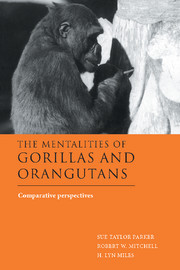Book contents
- Frontmatter
- Contents
- List of contributors
- Preface
- Acknowledgments
- I Comparative evolutionary and developmental perspectives on gorillas and orangutans
- II Cognition and tool use in gorillas and orangutans
- III Communication in gorillas and orangutans
- IV Social cognition in gorillas and orangutans
- V Epilogue
- 19 The mentalities of gorillas and orangutans in phylogenetic perspective
- Index of authors
- Index of subjects
19 - The mentalities of gorillas and orangutans in phylogenetic perspective
Published online by Cambridge University Press: 20 October 2009
- Frontmatter
- Contents
- List of contributors
- Preface
- Acknowledgments
- I Comparative evolutionary and developmental perspectives on gorillas and orangutans
- II Cognition and tool use in gorillas and orangutans
- III Communication in gorillas and orangutans
- IV Social cognition in gorillas and orangutans
- V Epilogue
- 19 The mentalities of gorillas and orangutans in phylogenetic perspective
- Index of authors
- Index of subjects
Summary
This chapter is based on the premise that it is impossible to understand human evolution unless we study gorillas and orangutans as well as our closest living relatives, chimpanzees and bonobos. It is designed to redress the chimpocentric bias of primatologists (Beck, 1982) by reviewing recent data on the cognitive abilities of gorillas and orangutans, especially data presented in this volume. It is also designed to highlight aspects of gorilla and orangutan behavior and abilities heretofore neglected, misrepresented, or unknown. Finally, it is designed to review the similarities and differences among the four species of great apes using the cladistic method to show the evolutionary implications of these comparative data.
THE CLADISTIC APPROACH TO PHYLOGENETIC RECONSTRUCTION
The cladistic method for reconstructing the evolution of behavior involves comparing the taxonomic distribution of behaviors among all the species closely related to our target species. (In order to avoid circularity, it is important to use a cladogram previously constructed from molecular data.) Through this systematic process of comparison, it is possible to determine which characteristics are (1) shared with members of other taxonomic groups (shared characters), (2) shared only by a group of sister species (shared–derived characters), and (3) unique to a given species (derived characters). From this it is possible to identify the putative common ancestors in whom particular shared derived characteristics must have arisen.
These patterns can only be determined through comparisons among the ingroup species, and between those species and more distantly related outgroup species Brooks & Mclennan, 1991; Harvey & Pagel, 1991).
- Type
- Chapter
- Information
- The Mentalities of Gorillas and OrangutansComparative Perspectives, pp. 397 - 411Publisher: Cambridge University PressPrint publication year: 1999
- 1
- Cited by



